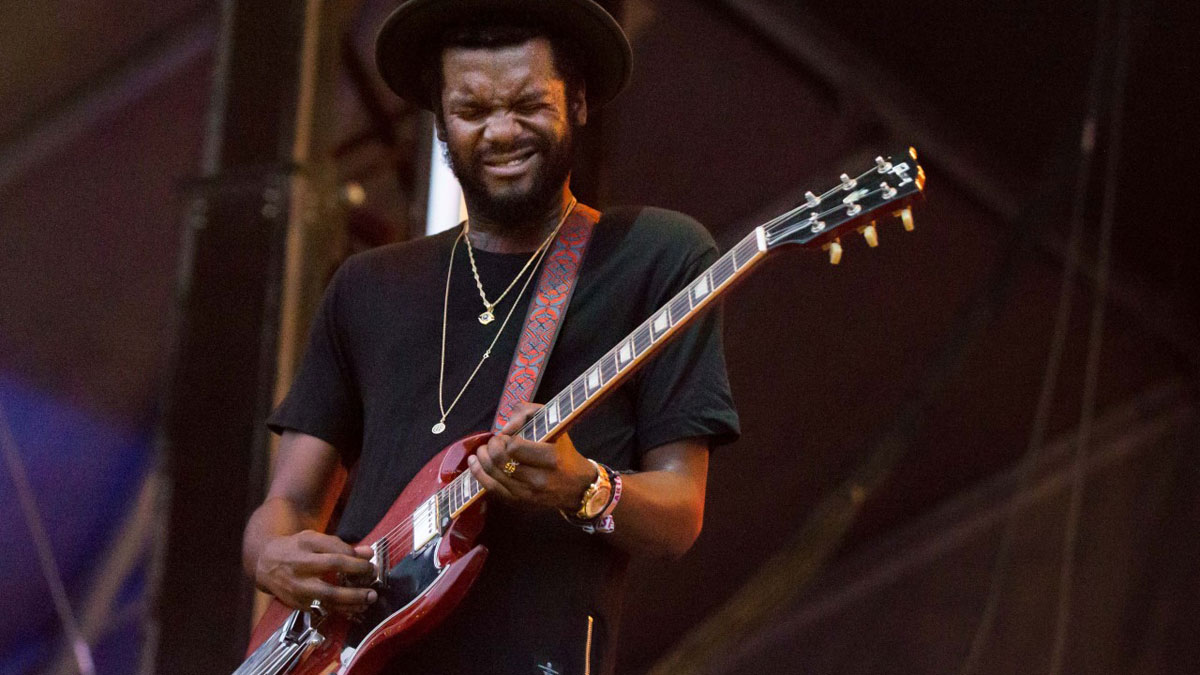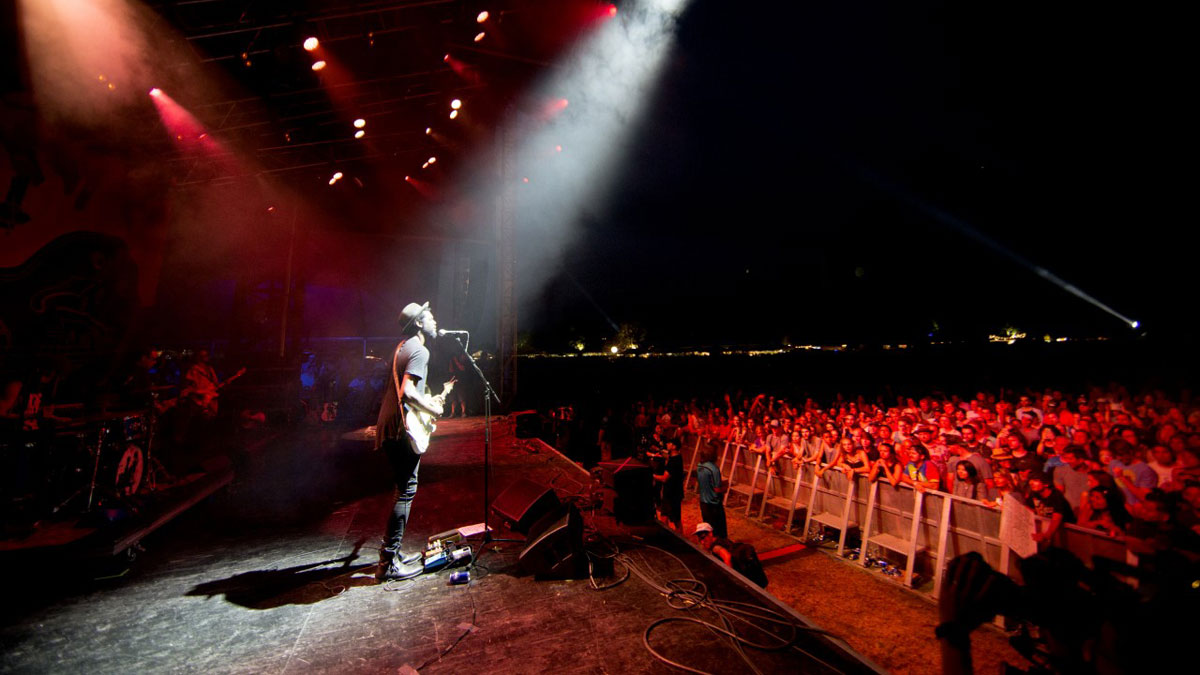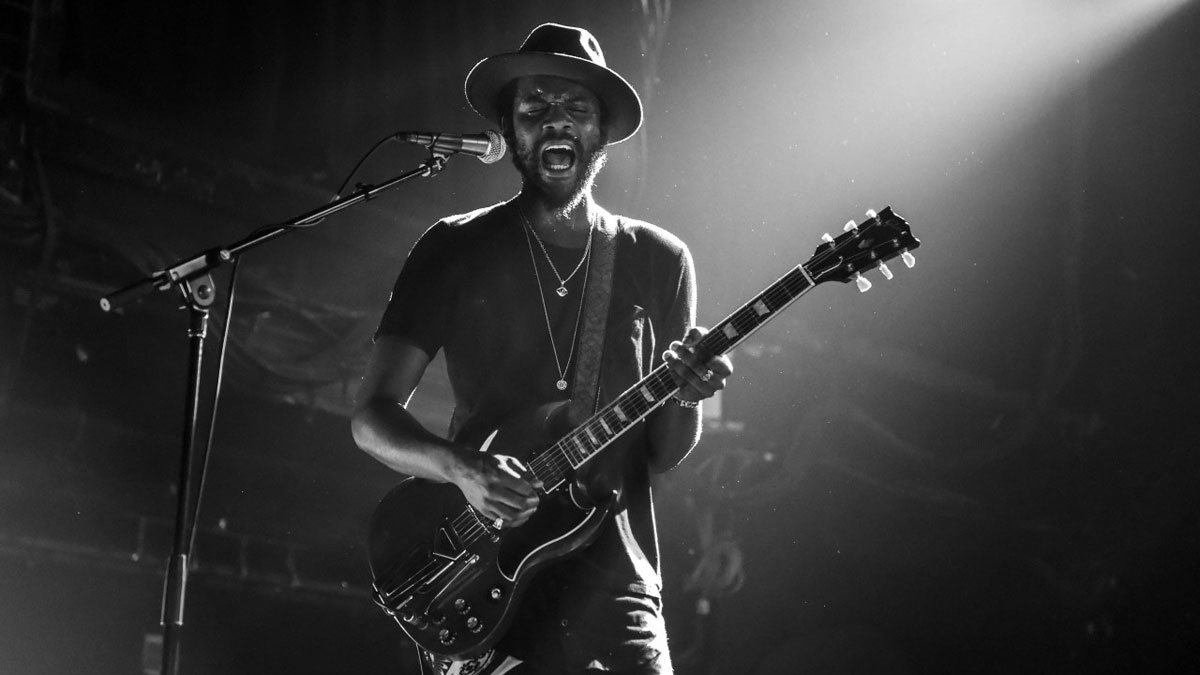Gary Clark Jr on improvisation, Derek Trucks and the secret of his sound
Down-time with the modern blues rock icon

Introduction
Gary Clark Jr’s guitar journey has catapulted him far beyond the Austin blues scene that bore him. We sit down with him to find out the secret of his success…
Gary Clark Jr is an ocean of calm. Sat in a room in Warner’s plush London headquarters, the guitarist looks as relaxed as can be. Cool, composed, oozing quiet confidence. And it’s contagious - you can’t help be around the guy and not feel some sense of inner zen.
Having recorded and released his second album for Warner Bros this year, titled The Story Of Sonny Boy Slim, the 31 year-old Texan has become the poster boy of modern blues.
I don’t think the blues is in need of anything. It can stand on its own, as the root and foundation of music
He’s earned his stripes through the same Austin scene that produced legends such as Stevie Ray and Jimmie Vaughan, jammed with his biggest heroes - in front of President Obama - boldly daring to take the genre to new chart-bothering heights.
His most recent body of work continues to stray beyond the familiar 12-bar turnarounds, incorporating all the right elements of funk, soul and hip-hop into the mix.
It’s old-school values delivered in contemporary style, with taste at the very heart of the equation. But call him the saviour of his genre and Clark will politely correct you. He’s far from it, at least in his eyes…
“I don’t think the blues is in need of anything,” he shrugs with a smile. “It can stand on its own, as the root and foundation of music. You can’t have any vegetation without roots. I grew up in a house where I was taught to remember where you come from, don’t forget who you are, but always look forward and never remain stagnant. Encourage yourself to push the limits and see how far you can go.
“Plus it’s 2015, there are so many ways to express yourself and so many tools to help you do it. For me to be a true artist, I need to use all the brushes and all the colours and see what I can do.
“It sounds dumb, but what use is a car to me if I just keep it parked on the street? Or if it can only go backwards - that’s no fun. Go forwards and see how far it goes. I don’t ever wanna stay stuck, but it’s no disrespect to the past.”
Don't Miss
Gary Clark Jr. talks blues, guitars and Blak And Blu

Roots
The singer, guitarist and occasional actor is quick to point out his differences to the blues of old. Stylistic comparisons may get made - as to be expected with any blues artist - but while influences cannot be understated, his life story was always going to be somewhat different. In Gary Clark Jr’s mind, we’re all a product of our personal experience.
“You know, it’s not like I grew up in the Delta picking cotton,” he says. “I wasn’t in that time. I would be playin’ myself if I went around pretending to be some straight-up blues guy saying, ‘I used to kick it with Muddy Waters!’ [laughs] I grew up playing with the band in a baptist church with a gospel choir, so a lot of that kinda influence comes from the bandstand or sitting on the pew my parents would drag me to when I was a kid.
I might at some point switch it up and come at you with some rockers, or a jazz album… who knows!
“I’m just being true to who I am and I love all kinds of music. So naturally, being aware of that, I absorb different sounds like a sponge. You soak it up, then wring it out to see what happens.”
There’s definitely a rebel streak in there, and perhaps that’s the secret to his unique charm. He’s grateful for the fruits of his hard labour, but simultaneously has little care for accolades that come with it.
He’s a musician who is disarmingly unapologetic to the purists who feel blues should be cemented into certain rhythms and movements, those who condemn further sonic exploration as blasphemy.
“There’s been a little bit of resistance, but that’s not really my issue," he sympathises. “I’m me… an individual. I can’t pay attention to somebody tryin’ to keep me in a place I don’t wanna be. I might at some point switch it up and come at you with some rockers, or a jazz album… who knows!
“Don’t get me wrong, I’m always up for playing a I-IV-V… I love it. But I wouldn’t be happy if I was doing what other people expected of me, playing by some rules they have in their head about what music should be. I don’t think about that stuff at all.”

Story of the blues
Whatever he’s doing, it definitely seems to be working. One listen to The Story Of Sonny Boy Slim confirms the Texan knows his way around the fretboard, and has a knack for making guitars scream.
The thick, fuzz-marinated leads and roaring feedback heard on Grinder will have you wincing - in the best possible way. You get the impression Clark is a man that knows when to wrestle his guitar into submission, as well as when to tone it down. It’s the kind of album that conjures apparitions of vintage Strats and 335s fed into rusty fuzz pedals and through to dusty combos in a basement club on the outskirts of town.
A lot of the sound came from microphone placement and using the space around us
Gary Clark Jr’s guitar work is raw and honest as it gets, from beginning to end. In today’s world of gear modelling and profiling, it’s certainly a breath of fresh air. Clark maintains it was more important to capture the sounds right at source than rely on manipulating his signal at a later stage.
“I just used a lot of my normal gear on this record,” he affirms. “A Vibro-King and a Princeton, mainly. A lot of the sound came from microphone placement and using the space around us - not just crushing the mics with the speakers right in front. A lot of my favourite records have a sound that comes from the room… I think that has more to do with it than, say, gear.
“I find it’s not what you play, but more about how you use it. And using old mics was important this time too: we’d use ones that crunch up and distort in the right places, which would mess with the tones, frequencies and equalisation.
“On Shake I used my ’61 Les Paul SG reissue, this little red thing I got, going straight into the Vibro-King turned all the way up with some reverb on top. There’s a wah on The Healing which I think we put in after the overdrive. In general, it’s never too complicated with me. I like to keep things pretty simple.
“I used a Strat on Can’t Sleep because I just wanted to be Nile Rodgers! What a great talent, to be able to find your own thing and get people moving all over the world. He’s stupidly good, and there’s definitely an influence there. As soon as I heard those new Daft Punk songs… I knew it had to be Nile. Who else could it be?”

Live and dangerous
An extension of Clark’s musical openness is his attitude to live interpretations of his work. It’s not so much about recreating the sounds committed to tape as it is breathing new life into his songs.
The guitarist admits he often finds the stage the most natural birthplace for new ideas. Embracing the variables and allowing them to filter through naturally not only makes each performance stand out for the audience, but the musicians on stage too.
When it comes to improvisation... you reach the zone, it’s like 30,000 feet and you just keep going
“I saw this Stevie Ray Vaughan retrospective and they were talking about his intensity and how he never played the same thing twice,” admits Clark. “That really stuck with me, you know? When it comes to improvisation, if it’s feeling really good you go to this place that’s hard to describe. You reach the zone, it’s like 30,000 feet and you just keep going. And it’s a combination of the guys in the band - what they hear and bring to the table.
“I don’t want to be stuck and locked into playing songs a certain way. I tell them, ‘Okay, this is how it’s recorded but there’s room to stretch here and if you feel a certain way, don’t hold back.’
“Then there’s the energy of the crowd, they can make us play faster or longer or tighten it up and I love that. It keeps things exciting, you can play songs on the road for so long until you need to switch it up and start having fun.”

Scaling up
Of course, something that always helps is having a few scales under your belt - and perhaps one in particular. While there’s a major second, major 6th or b5 dotted around, he mainly sticks to what he knows best. We had to ask: what’s the secret to mastering pentatonics? How do some players manage to get so much mileage out of the five-note scale?
“I wish I could tell you something intelligent but it’s mainly by process of elimination,” nods Clark. “I make a lot of mistakes on stage sometimes, and that only comes from trying new things out. Like if I’m playing a lead and just go off with chromatics… it could be a train wreck but I’m at least prepared for it!
Every time I pick up my slide I can only think about Derek Trucks! That dude has it figured out
“You have to use your ear. I never really had a guitar teacher, I just used to try things out and watch how people bend their strings on Austin City Limits or whatever television programme was on.
“I’d say a good starting point would be Lightnin’ Hopkins. Go listen to his records and you’ll start to pick things up. His licks have stuck through time, through blues and rock ’n’ roll, the whole way across.”
A knock on the door signals our time with the blues maverick is drawing to an end, but there’s just enough time for one last question. When you’ve played with everyone from BB King and Jeff Beck, to Alicia Keys and Foo Fighters, who else is there to look up to? Who are Clark’s peers now he’s regarded as one of the modern pioneers of his genre?
“You know there’s a fucked up thing about that...” teases Clark. “Every time I pick up my slide I can only think about Derek Trucks! [laughs] It’s like, ‘Dammit! I’m doing my best but I’m not him!’ He does it so effortlessly… you see him from the neck up and he could be taking a nap or having a coffee - just chillin’! That dude has it figured out.”
And the same could be said for Clark himself. For an artist that has been recording for little over a decade, he’s achieved things few could even dream of. Something tells us he’s only just getting started…
Gary Clark Jr’s The Story Of Sonny Boy Slim is available now on Warner Bros.
Don't Miss
Gary Clark Jr. talks blues, guitars and Blak And Blu
Amit has been writing for titles like Total Guitar, MusicRadar and Guitar World for over a decade and counts Richie Kotzen, Guthrie Govan and Jeff Beck among his primary influences. He's interviewed everyone from Ozzy Osbourne and Lemmy to Slash and Jimmy Page, and once even traded solos with a member of Slayer on a track released internationally. As a session guitarist, he's played alongside members of Judas Priest and Uriah Heep in London ensemble Metalworks, as well as handling lead guitars for legends like Glen Matlock (Sex Pistols, The Faces) and Stu Hamm (Steve Vai, Joe Satriani, G3).


